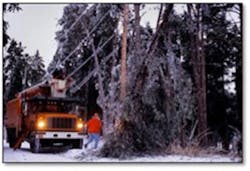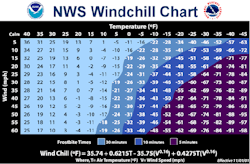You know it’s cold when the streets of New Orleans’ French Quarter are relatively empty, the fountains in Florida are covered in icicles and Midwest ski resorts are closed because of the temperature.
Many of us in the eastern half of the country are experiencing a polar vortex. According to the National Weather Service, a polar vortex is an arctic air mass that pushed far south, plunging the eastern and central United States down to record cold temperatures.
During this record-setting and deadly cold wave, workers are at increased risk of cold stress. Increased wind speeds can cause the air temperature to feel even colder, further increasing the risk of cold stress of those working outdoors. Mandy Edens, director of technical support and emergency management for OSHA, notes in a blog post on the Department of Labor’s blog, (Work in Progress), that a number of workers could be in danger from the cold, including snow cleanup crews, construction workers, recreational workers, postal workers, police officers, firefighters, miners, baggage handlers, landscapers, utility workers and support workers for oil and gas operations.
How Cold Is Too Cold?
Workers who must be outdoors in below zero weather conditions certainly are at risk of injury or even death, said Edens. “A cold environment forces the body to work harder to maintain its temperature. Cold air, water and snow all draw heat from the body. The most common problems faced in the cold are hypothermia, frostbite and trench foot.”
Appropriate preventive measures must be taken to protect workers who must be outside. Here are some tips from Edens’ (Work in Progress) blog post:
1.) Plan for work in cold weather. Wearing appropriate clothing and being aware of how your body is reacting to the cold are important to preventing cold stress. Avoiding alcohol, certain medications and smoking can also help minimize the risk.
2.) Protective clothing is the most important way to avoid cold stress. The type of fabric even makes a difference. Cotton loses its insulation value when it becomes wet. Wool, silk and most synthetics, on the other hand, retain their insulation even when wet. Here are some clothing recommendations for working in cold environments:
- Wear at least three layers of clothing. An inner layer of wool, silk or synthetic to wick moisture away from the body. A middle layer of wool or synthetic to provide insulation even when wet. An outer wind and rain protection layer that allows some ventilation to prevent overheating. Layering provides better insulation. Do not wear tight-fitting clothing.
- Wear a hat or hood to help keep your whole body warmer. Hats reduce the amount of body heat that escapes from your head.
- Wear insulated boots or other footwear.
- Keep extra clothing (including underwear) handy in case you get wet and need to change.
- Do not underestimate the wetting effects of perspiration. Often, wicking and venting of the body’s sweat and heat are more important than protecting from rain or snow.
With proper planning and training, employers can keep their employees safe during winter work. For more life-saving tips and information, check out OSHA’s winter weather resource page. Additional information on cold stress is available from the National Institute for Occupational Safety and Health, and those involved in mining operations should view this winter alert from the Mine Safety and Health Administration.
About the Author

Sandy Smith
Sandy Smith is the former content director of EHS Today, and is currently the EHSQ content & community lead at Intelex Technologies Inc. She has written about occupational safety and health and environmental issues since 1990.

